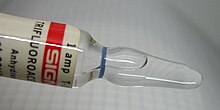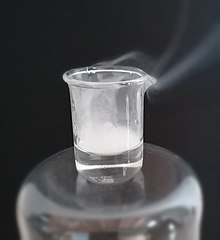Trifluoroacetic acid
| |||

| |||

| |||
| Names | |||
|---|---|---|---|
| Preferred IUPAC name
Trifluoroacetic acid | |||
| Other names
2,2,2-Trifluoroacetic acid
2,2,2-Trifluoroethanoic acid Perfluoroacetic acid Trifluoroethanoic acid TFA | |||
| Identifiers | |||
3D model (JSmol)
|
|||
| 742035 | |||
| ChEBI | |||
| ChEMBL | |||
| ChemSpider | |||
| ECHA InfoCard | 100.000.846 | ||
| 2729 | |||
PubChemCID
|
|||
| RTECS number |
| ||
| UNII | |||
CompTox Dashboard(EPA)
|
|||
| |||
| |||
| Properties | |||
| C2HF3O2 | |||
| Molar mass | 114.023g·mol−1 | ||
| Appearance | colorless liquid | ||
| Odor | Pungent/Vinegar | ||
| Density | 1.489 g/cm3,20 °C | ||
| Melting point | −15.4 °C (4.3 °F; 257.8 K) | ||
| Boiling point | 72.4 °C (162.3 °F; 345.5 K) | ||
| miscible | |||
| Vapor pressure | 0.0117 bar (1.17 kPa) at 20 °C[1] | ||
| Acidity(pKa) | 0.52[2] | ||
| Conjugate base | trifluoroacetate | ||
| -43.3·10−6cm3/mol | |||
| Hazards | |||
| Occupational safety and health(OHS/OSH): | |||
Main hazards
|
Highly corrosive | ||
| GHSlabelling: | |||
 
| |||
| Danger | |||
| H314,H332,H412 | |||
| P260,P261,P264,P271,P273,P280,P301+P330+P331,P303+P361+P353,P304+P312,P304+P340,P305+P351+P338,P310,P312,P321,P363,P405,P501 | |||
| NFPA 704(fire diamond) | |||
| Safety data sheet(SDS) | External MSDS | ||
| Related compounds | |||
Related perfluorinated acids
|
Heptafluorobutyric acid Perfluorooctanoic acid Perfluorononanoic acid | ||
Related compounds
|
Acetic acid Trichloroacetic acid | ||
Except where otherwise noted, data are given for materials in theirstandard state(at 25 °C [77 °F], 100 kPa).
| |||
Trifluoroacetic acid(TFA) is anorganofluorinecompound with thechemical formulaCF3CO2H. It is ahaloacetic acid,with all three of the acetyl group's hydrogen atoms replaced by fluorine atoms. It is a colorless liquid with avinegar-like odor. TFA is a stronger acid than acetic acid, having anacid ionisation constant,Ka,that is approximately 34,000 times higher,[3]as the highlyelectronegativefluorine atoms and consequentelectron-withdrawing natureof thetrifluoromethylgroup weakens the oxygen-hydrogen bond (allowing for greater acidity) and stabilises theanionicconjugate base.TFA is widely used inorganic chemistryfor various purposes.
Synthesis
[edit]TFA is prepared industrially by theelectrofluorinationofacetyl chlorideoracetic anhydride,followed by hydrolysis of the resultingtrifluoroacetyl fluoride:[4]
- CH
3COCl+ 4HF→CF
3COF+ 3H
2+HCl - CF
3COF+H
2O→CF
3COOH+HF
Where desired, this compound may be dried by addition oftrifluoroacetic anhydride.[5]
An older route to TFA proceeds via the oxidation of 1,1,1-trifluoro-2,3,3-trichloropropene withpotassium permanganate.The trifluorotrichloropropene can be prepared bySwarts fluorinationofhexachloropropene.[6]
Uses
[edit]
TFA is the precursor to many other fluorinated compounds such astrifluoroacetic anhydride,trifluoroperacetic acid,and2,2,2-trifluoroethanol.[4]It is areagentused inorganic synthesisbecause of a combination of convenient properties: volatility, solubility in organic solvents, and its strength as an acid.[7]TFA is also less oxidizing thansulfuric acidbut more readily available in anhydrous form than many other acids. One complication to its use is that TFA forms anazeotropewith water (b. p. 105 °C).
TFA is popularly used as a strong acid to removeprotecting groupssuch asBocused in organic chemistry andpeptide synthesis.[8][9]
At a low concentration, TFA is used as an ion pairing agent inliquid chromatography(HPLC) of organic compounds, particularlypeptidesand smallproteins.TFA is a versatile solvent forNMR spectroscopy(for materials stable in acid). It is also used as a calibrant in mass spectrometry.[10]
TFA is used to produce trifluoroacetate salts.[11]
Safety
[edit]Trifluoroacetic acid is a corrosive strong acid[12]but it does not pose the hazards associated withhydrofluoric acidbecause thecarbon-fluorine bondis notlabile.TFA is harmful when inhaled, causes severe skin burns and is toxic for aquatic organisms even at low concentrations.
The reaction of TFA with bases and metals, especiallylight metals,is strongly exothermic. For example, reaction of TFA withlithium aluminium hydride(LAH) may result in anexplosion.[13]
TFA is a metabolic breakdown product of thevolatile anesthetic agenthalothane.It is thought to be responsible for halothane-inducedhepatitis.[14]
Environment
[edit]No known natural processes generate trifluoroacetic acid.[15]In the environment, trifluoroacetic acid may be formed byphotooxidationof the commonly usedrefrigerant1,1,1,2-tetrafluoroethane(R-134a).[citation needed]Moreover, it is formed as an atmospheric degradation product of almost all fourth-generation synthetic refrigerants, also calledhydrofluoroolefins(HFO), such as2,3,3,3-tetrafluoropropene.[citation needed]
Trifluoroacetic aciddegrades very slowlyin the environment, and has been found in increasing amounts as a contaminant in water, soil, food, and the human body.[16]Median concentrations of a few micrograms per liter have been found in beer and tea.[17]Sea water contains about 200 ng of TFA per liter.[18][19][20]No biodegradation mechanism for the compound is known in water,[21]althoughbiotransformationapparentlydecarboxylatesthe acid tofluoroform.[22]
Trifluoroacetic acid is mildlyphytotoxic.[23]
See also
[edit]- Fluoroacetic acid– highly toxic but naturally occurringrodenticideCH2FCOOH
- Difluoroacetic acid
- Trichloroacetic acid,the chlorinated analog
References
[edit]- ^Kreglewski, A. (1962)."Trifluoroacetic acid".Welcome to the NIST WebBook.10(11–12): 629–633.Retrieved1 March2020.
- ^W. M. Haynes.; David R. Lide; Thomas J. Bruno, eds. (2016–2017).CRC Handbook of Chemistry and Physics.CRC Press. pp. 954–963.ISBN978-1-4987-5429-3.
- ^Note:Calculated from the ratio of theKavalues for TFA (pKa= 0.23) and acetic acid (pKa= 4.76)
- ^abG. Siegemund; W. Schwertfeger; A. Feiring; B. Smart; F. Behr; H. Vogel; B. McKusick. "Fluorine Compounds, Organic".Ullmann's Encyclopedia of Industrial Chemistry.Weinheim: Wiley-VCH.doi:10.1002/14356007.a11_349.ISBN978-3527306732.
- ^Wilfred L.F. Armarego & Christina Li Lin Chai (2009). "Chapter 4 - Purification of Organic Chemicals".Purification of Laboratory Chemicals(6th ed.). pp. 88–444.doi:10.1016/B978-1-85617-567-8.50012-3.ISBN978-1-85617-567-8.
- ^Gergel, Max G.(March 1977).Excuse me sir, would you like to buy a kilo of isopropyl bromide?.Pierce Chemical. pp. 88–90.
- ^Eidman, K. F.; Nichols, P. J. (2004). "Trifluoroacetic Acid". In L. Paquette (ed.).Encyclopedia of Reagents for Organic Synthesis.New York: J. Wiley & Sons.doi:10.1002/047084289X.rt236.pub2.hdl:10261/236866.ISBN978-0-471-93623-7.
- ^Lundt, Behrend F.; Johansen, Nils L.; Vølund, Aage; Markussen, Jan (1978). "Removal of t-Butyl and t-Butoxycarbonyl Protecting Groups with Trifluoroacetic acid".International Journal of Peptide and Protein Research.12(5): 258–268.doi:10.1111/j.1399-3011.1978.tb02896.x.PMID744685.
- ^Andrew B. Hughes (2011). "1. Protection Reactions". In Vommina V. Sureshbabu; Narasimhamurthy Narendra (eds.).Amino Acids, Peptides and Proteins in Organic Chemistry: Protection Reactions, Medicinal Chemistry, Combinatorial Synthesis.Vol. 4. pp. 1–97.doi:10.1002/9783527631827.ch1.ISBN978-3-527-63182-7.
- ^Stout, Steven J.; Dacunha, Adrian R. (1989). "Tuning and calibration in thermospray liquid chromatography/mass spectrometry using trifluoroacetic acid cluster ions".Analytical Chemistry.61(18): 2126.doi:10.1021/ac00193a027.
- ^O. Castano; A. Cavallaro; A. Palau; J. C. Gonzalez; M. Rossell; T. Puig; F. Sandiumenge; N. Mestres; S. Pinol; A. Pomar & X. Obradors (2003). "High quality YBa2Cu3O7thin films grown by trifluoroacetates metal-organic deposition ".Superconductor Science and Technology.16(1): 45–53.Bibcode:2003SuScT..16...45C.doi:10.1088/0953-2048/16/1/309.S2CID250765145.
- ^Henne, Albert L; Fox, Charles J (1951)."Ionization constants of fluorinated acids".Journal of the American Chemical Society.73(5): 2323–2325.doi:10.1021/ja01149a122.
- ^Safety data sheet forTrifluoroacetic acid(PDF) from EMD Millipore, revision date 10/27/2014.
- ^"Halothane",LiverTox: Clinical and Research Information on Drug-Induced Liver Injury,Bethesda (MD): National Institute of Diabetes and Digestive and Kidney Diseases, 2012,PMID31643481,retrieved15 July2021
- ^Joudan, Shira; De Silva, Amila O.; Young, Cora J. (2021). "Insufficient evidence for the existence of natural trifluoroacetic acid".Environmental Science: Processes & Impacts.23(11): 1641–1649.doi:10.1039/D1EM00306B.hdl:10315/40884.ISSN2050-7887.PMID34693963.S2CID239768006.
- ^Hosea, Leana; Salvidge, Rachel (1 May 2024)."Rapidly rising levels of TFA 'forever chemical' alarm experts".The Guardian.ISSN0261-3077.Retrieved29 May2024.
- ^Marco Scheurer, Karsten Nödler (2021). "Ultrashort-chain perfluoroalkyl substance trifluoroacetate (TFA) in beer and tea – An unintended aqueous extraction".Food Chemistry.351:129304.doi:10.1016/j.foodchem.2021.129304.ISSN0308-8146.PMID33657499.S2CID232115008.
- ^Frank, H.; Christoph, E. H.; Holm-Hansen, O.; Bullister, J. L. (January 2002). "Trifluoroacetate in ocean waters".Environ. Sci. Technol.36(1): 12–5.Bibcode:2002EnST...36...12P.doi:10.1021/es0221659.PMID11811478.
- ^Scott, B. F.; MacDonald, R. W.; Kannan, K.; Fisk, A.; Witter, A.; Yamashita, N.; Durham, L.; Spencer, C.; Muir, D. C. G. (September 2005). "Trifluoroacetate profiles in the Arctic, Atlantic, and Pacific Oceans".Environ. Sci. Technol.39(17): 6555–60.Bibcode:2005EnST...39.6555S.doi:10.1021/es047975u.PMID16190212.
- ^Frank, Hartmut; Christoph, Eugen H.; Holm-Hansen, Osmund; Bullister, John L. (2002). "Trifluoroacetate in Ocean Waters".Environmental Science & Technology.36(1): 12–15.Bibcode:2002EnST...36...12F.doi:10.1021/es0101532.ISSN0013-936X.PMID11811478.
- ^"Refreshingly cool, potentially toxic".Ludwig-Maximilians-Universität (LMU) Munich.2014.Retrieved26 July2018.
- ^Kirschner, E., Chemical and Engineering News 1994, 8.
- ^Boutonnet, Jean Charles; Bingham, Pauline; Calamari, Davide; Rooij, Christ de; Franklin, James; Kawano, Toshihiko; Libre, Jean-Marie; McCul-Loch, Archie; Malinverno, Giuseppe; Odom, J Martin; Rusch, George M; Smythe, Katie; Sobolev, Igor; Thompson, Roy; Tiedje, James M (1999). "Environmental risk assessment of trifluoroacetic acid".International Journal of Human and Ecological Risk Assessment.5(1): 59–124.Bibcode:1999HERA....5...59B.doi:10.1080/10807039991289644.



